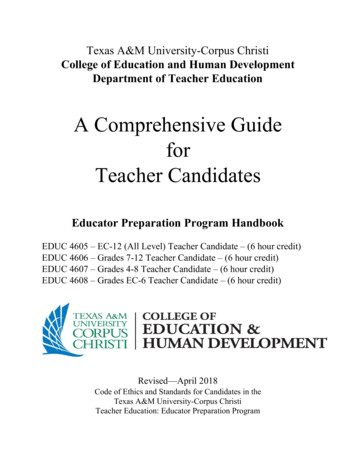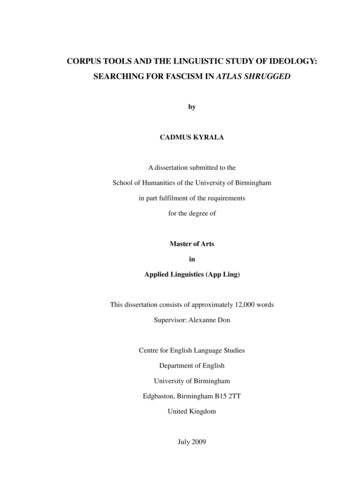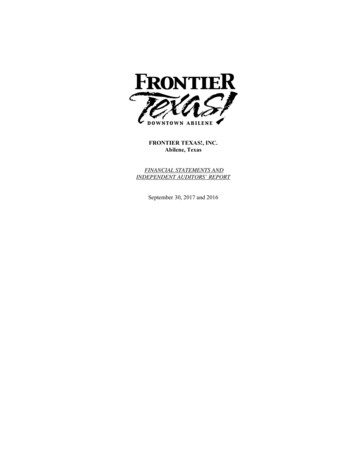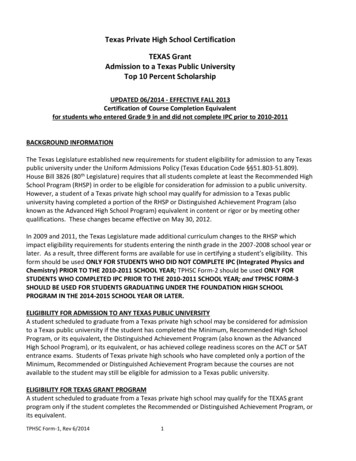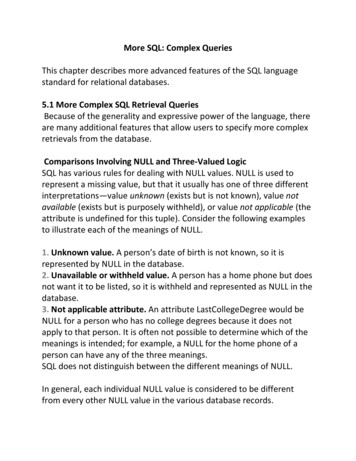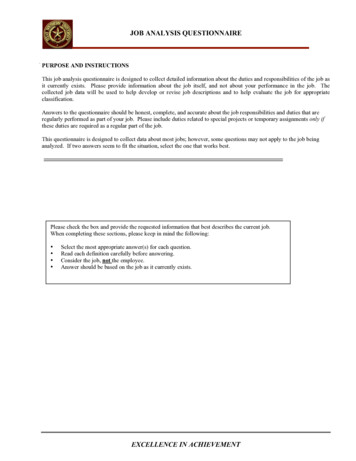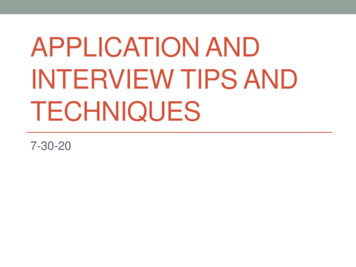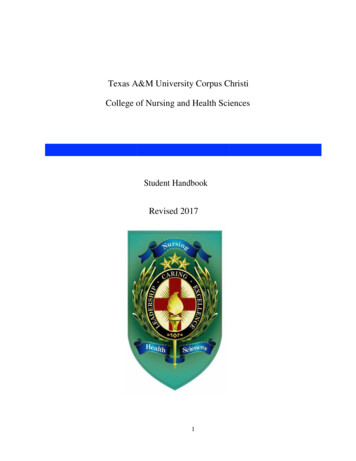
Transcription
Texas A&M University Corpus ChristiCollege of Nursing and Health SciencesStudent HandbookRevised 20171
Table of ContentsI. IntroductionBrief History of the College of Nursing and Health SciencesThe Baccalaureate Nursing ProgramThe Graduate Nursing ProgramHistory of Health Care and Health Science at TAMUCCState of Accreditation6-9II. College Mission, Philosophy, Goals and ConceptualFrameworkMission StatementPhilosophyCollege of Nursing & Health Sciences GoalsConceptual Framework9 -11III. Nursing Undergraduate CurriculaUndergraduate Expected OutcomesPre-Licensure Baccalaureate Curriculum PlanOrganizational PrincipleDescription of Organizational PrincipleProgressive and Persuasive ThemesRN-BSN TrackRN-BSN Option Curriculum PlanCourse Sequencing Schedule12 - 19IV. Nursing Graduate CurriculumProgram Goals and Expected OutcomesMSN Program OverviewGraduate Student Entry and Progression RequirementsGraduate Programs20 - 23V. Organization and InfrastructureOrganizationUndergraduate Department CommitteeFunctionsGraduate AffairsFunctions24 - 25VI. ResourcesNursing Learning Resource Center (NLRC)Center for Academic Student Achievement (CASA)Success CounselorsOther Resources25 - 272
VII. Student OrganizationsStudent Nurses AssociationStudent GovernmentAmerican College of Healthcare ExecutivesSigma Theta Tau International27VIII. Rights and ResponsibilitiesRightsStudent Responsibilities within the College of Nursing andHealth SciencesStudent Rights and ObligationsPolicy StatementProcedures and Responsibilities27 -31IX. Policies and RegulationsUniversity CatalogUniversity Student HandbookAcademic Honesty and Professional Integrity PolicyAcademic MisconductCheatingPlagiarismMultiple SubmissionsCollusionFabrication, Falsification, or MisrepresentationProfessional IntegrityViolations of Professional IntegritySanctions of ViolationsGrade Appeal Policy and ProcessGrade Appeal CommitteeThe Appeal ProcessProceedings of the College Grade Appeal CommitteeAcademic AdvisementStudent RecordsProgression, Grading, and Graduation PoliciesProgressionClinicalsClinical Evaluation ToolGraduationGraduation Under a Particular Catalog – UndergraduateProgramsApplication for Graduation – Undergraduate ProgramsGraduation Under a Particular Catalog – Graduate ProgramsApplication for Graduation – Graduate ProgramsStandard PrecautionsLatex31 - 763
Prescription for Remediation – Pre-Licensure BSN StudentsSkills RemediationOverriding Areas of Clinical ConcernsSafetyCommunicationAsepsisGradingWritten AssignmentsAPA GuidelinesGeneral APA GuidelinesGuidelines to Reduce Bias in LanguageCitation of SourcesProfessional Behavior and Safe PracticeIntroductionDefinitions of Unacceptable BehaviorNurse-Patient RelationshipsSocial MediaTransportationJoint EnrollmentUniversity EquipmentUniforms, Patches, Name TagsStudent Dress Code – Undergraduate StudentsScholarship and Financial AidRecognitionSelection of Award RecipientsAwardsOutstanding Graduating SeniorOutstanding Graduating RN/BSNOutstanding Graduating eLine Student AwardOutstanding Graduate StudentUndergraduate Community AwardUndergraduate Research AwardGraduate Research AwardThe O’Neil Award for CaringLiability InsuranceBackground ChecksTechnical Standards for Nursing CollegeObservationCommunicationMotor Coordination or FunctionIntellectual-Conceptual, Integrative and Quantitative AbilitiesBehavioral and Social AttributesTechnical Standards Questions for Nursing StudentsHandicapped PersonPhysical or Mental Impairment4
Qualified Handicapped PersonStandards for Completion of the CurriculumStudent Chemical Dependency Peer Review Policy (BSN)PurposeReportingReporting ProcessNurse Practice Act Peer Review Policy and Procedure (Studentand Faculty with RN License)Reportable ConductMinor IncidentsProtection to RNs Refusing to Engage in Reportable ConductProcedureNurse Practice Act – Declaratory Orders2.13.27 Good Professional Character213.28. Licensure of Persons with Criminal Convictions213.29. Criteria and Procedure Regarding Intemperate Useand Lack of Fitness in Eligibility and Disciplinary Matters213.30. Declaratory Order of Eligibility for Licensure217.11. Standards of Professional Nursing Practice217.12. Unprofessional ConductPetition for Declaratory OrdersDeclaratory Order Petition Packet RequestLicensure Eligibility Notification FormStudent Handbook Receipt Form7Appendix B – College of Nursing and Health Science Student77Grade Appeal FormFaculty Grade Appeal Response FormDepartment Chair Grade Appeal Response FormStudent Grade Appeal Response FormAssociate Dean Grade Appeal Response Form79808182Appendix C – Latex Sensitivity Screening83Appendix D – Request for Remediation84Appendix – Issues of Clinical Concern855
I. IntroductionBrief History of the College of Nursing & Health SciencesIn 1972, a delegation of community nursing leaders led by Elizabeth Willis, Chairperson ofRegistered Nurses Education at Del Mar College, met with the first Dean of the College ofScience and Technology, Dr. Ralph Gilchrist, to study a number of successful upper-levelnursing programs in the United States. Application for an Upper-Level Nursing Program atUniversity of Corpus Christi (UCC) was made to the Coordinating Board, Texas Collegeand University System. In July 1974, University of Corpus Christi (UCC) one of threeuniversities in the state approved to implement the multiple entry/exit model curriculumdesigned by the Study Committee on Nursing Education of the Coordinating Board.The Baccalaureate Nursing Program: The Baccalaureate Nursing Program at Texas A&MUniversity-Corpus Christi (TAMUCC) then known as University of Corpus Christi (UCC) wasestablished in 1974. Research conducted by the Study Committee of Nursing Education of theCoordinating Board, Texas College and University System, had identified the need for increasednumbers of nurses in Texas at all educational levels, especially those prepared for teaching andleadership. The results also indicated the need for an upper-level nursing program in SouthTexas. Graduates of the five associate degree nursing programs in the region who wanted tofurther their education found that the nearest baccalaureate nursing programs were 160 to 220miles away. The majority of those who moved away from the area to go to college neverreturned. This migration left an even greater deficit in the numbers of available graduates.(Toward Quality Health Care: The Improvement of Nursing and Nursing Education in Texas,1974.)The Baccalaureate Program for Registered Nurses at the University of Corpus Christi (UCC)(Texas A&M University-Corpus Christi) began on a limited scale in the fall of 1974, becomingfully operational in the fall of 1975. Dr. Ruth M. Bakke was the first director of theBaccalaureate Nursing Program. Initial accreditation by the National League for Nursing (NLN)was attained December, 1979, retroactive for eight months. The Baccalaureate Nursing Programwas the first RN-BSN program in Texas to be accredited by NLN. Continuing accreditation wasgranted by the NLN Board of Review in March, 1985. The program was reaccredited in fall,1992 by NLN with full accreditation to 2002. Accreditation occurred in 1998 by CCNE, withreaccreditation in 2005 and scheduled visit for reaccreditation in Oct 2015.In 2001, the College of Nursing and Health Sciences received a grant from the Learning AnytimeAnywhere Partnership (LAAP) and from the Fund for the Improvement of PostsecondaryEducation (FIPSE) for the development of an online nursing education track. Throughcollaboration between Associate’s Degree in Nursing (ADN) and Bachelor of Science in Nursing(BSN) educational partnerships, the eLine track was established and became operational in2003. The online modular-based nursing education became first online generic Bachelor ofScience in Nursing (BSN) in the nation.In 2010 the CONHS received a grant from the Health Resources and Services Administration(HRSA). The White House and the Department of Defense has repeatedly recognized the6
program for its unique mission to fill two critical needs in our nation: a nursing shortage andcivilian employment for military veterans. The eLine Military (ELM) track, is a competencybased online program with face-to-face clinical experience, which facilitates access to a fullcurriculum to obtain a Bachelor’s of Science in Nursing (BSN) degree and pathway toRegistered Nurse (RN) licensure. The program developed an individualized Prior LearningAssessment (PLA), awarding the maximum amount of college credit based upon prior learningfrom medical training and experience obtained while serving in the military.The eLine Military Nursing track at Texas A&M University-Corpus Christi, was the recipientof the 2013 American Association of Colleges of Nursing (AACN) Innovations in ProfessionalNursing Education Award.The Graduate Nursing Program: The Graduate Nursing Program at the Texas A&MUniversity-Corpus Christi was established in 1984 as one of the Corpus Christi State Universitygraduate programs. The program offered registered nurses the opportunity to expand their scopeof practice in one of three specialty areas: advanced clinical practice, nursing administration, ornursing education. Students earn their Master of Science in Nursing (MSN) upon completion ofcore and specialty course work in tracks now known as Family Nurse Practitioner, Leadership inNursing Systems, and Nurse Educator areas of study. Starting in 1996, nurses who have notearned the BSN degree were also admitted to the MSN program through the RN-MSN entryoption. The MSN program initially was accredited by the National League for Nursing in theacademic year 1988-89. The Master of Science in Nursing program has maintained accreditationsince 1989 and is now currently accredited by CCNE. The MSN program will undergo programreview again in October 2015.With the goal of meeting regional and state needs and as a component of the faculty’scommitment to educating the nursing and healthcare leaders for tomorrow, the graduate nursingprogram has been offered to students in distant sites. Outreach sites supported students living andworking in the Rio Grande Valley, Laredo, Temple, Victoria and Weslaco, Texas. The facultyinitially drove to these sites, moving shortly to incorporating audio-conferencing technology,then fixed image transmission, progressing to slow scan video-conferencing as the method ofcourse delivery. Faculty had access to the slow scan television after Corpus Christi StateUniversity joined the A&M University System in 1989. At that time, the Texas legislatureauthorized the name change from Corpus Christi State University to Texas A&M UniversityCorpus Christi. Enrollment in A&M University-Corpus Christi MSN program grew with accessto televised real-time classes. Faculty supplemented these televised class interactions throughregular travel to the regional sites. By 2002 web-based computer delivery of classes was thenorm. The interactive high-definition distance education technology available through theInternet provided access to graduate nursing education for working nurses living and working inrural areas. Neither students nor faculty had to travel to engage in learning activities. The MSNprogram now offers all of its tracks only through web-based course management systems. TheMSN programs were initially was accredited by the National League for Nursing in the academicyear 1988-89. The Master of Science in Nursing program has maintained accreditation since1989 and is now currently accredited by CCNE. The MSN program will undergo CCNE reaccreditation in October 2015Accreditation.7
After Dr. Ruth Bakke was named Dean of Science & Technology, in the 80’s, the BSN and MSNprograms were chaired by Dr. Susan Nelson and Dr. Elizabeth Erkel. In August, 1989, Dr.Noreen C. O'Neill was invited to Texas A&M University-Corpus Christi to direct the Division ofNursing. Her mission was to reorganize its administrative structure, fortify its infrastructure andhelp develop new programs. In 1990, after receiving the approval of multiple oversight groups,the generic BSN option was implemented as a four-semester, upper-division nursing major. AfterDr. O’Neil retired in 1994, Dr. Rebecca A. Jones (August 1994) assumed the directorship. Inspring, 1995, the Division became a School of Nursing and two program coordinator positionswere approved. Dr. Mary Jane Hamilton was appointed by the Director as UndergraduateProgram and Dr. Claudia Johnston was appointed as Graduate Program Coordinator.Health Care Administration and Health Sciences: An interdisciplinary committee began theHealth Care Administration (HCA) minor in 1992. The minor is available to students choosinghealth care as a focus for future administrative positions in support of the Master's in PublicAdministration or Business Administration programs. A certificate in Health CareAdministration is available for those students who hold a Master's degree in another field andwish to complete a short course of study focused on Health Care Administration. The first groupof students to complete the minor graduated with their M.P.A. in May of 1995. Dr. ClaudiaJohnston served as the founding Program Coordinator. The Bachelor of Science in HealthSciences provides enrichment opportunities at the baccalaureate level for students with technicaldegrees in Allied Health. The program has been revised to accommodate freshmen choosingHealth Science as a major which prepares graduates for a variety of career opportunities in thehealth care field by providing the management skills necessary for success.The program was approved by the Texas Higher Education Coordinating Board and the firstgroup of students was admitted in the fall, 1994. The first graduates completed the program inDecember 1996. Dr. Whitney Bischoff served as the first program coordinator and Dr. WilliamKoprowski joined the faculty in the fall of 1995 as the program coordinator. The currentprogram coordinator, Dr. Sherdeana Owens, joined the faculty in 2010. The Health SciencesStudent Association was established in the Fall, 2011 semester. This organization providesopportunities for leadership, networking, community service and socialization.In fall of 2003, the university administration, with the rapid growth in the School of Nursingproposed to the A&M system and the Texas Higher Education Coordinating Board that theSchool become a College of Nursing and Health Sciences. In October 2004 the Convocationcelebrating the College of Nursing and Health Sciences took place. Dean Mary Jane Hamiltonwas installed by President Dr. Robert Furgason as the Founding Dean. Dr. Bunny Forgione wasappointed Associate Dean and Dr. Karen Koozer-Olson was appointed the OutreachCoordinator. Dr. Linda Cook was appointed Undergraduate Chair and Dr. Eve Layman wasappointed Graduate Chair.The CONHS in 2012) expanded its graduate programs to include a cooperative Doctor ofPhilosophy in Nursing Science program through a partnership with the Denton campus of theTexas Woman’s University (TWU). Students enrolled in this program earn their degree fromTWU. Members of the A&M University-Corpus Christi faculty provide student support throughtheir roles on advisory and research committees. The first student graduated from this partnership8
in 2013. The College added a new doctoral program with the approval of the Doctor of NursingPractice program. The first cohort of students will be admitted in fall 2016.Currently (2015) the administrative structure consists of the Dean (Dr. Mary Jane Hamilton),Associate Dean (Dr. Bunny Forgione), Associate Dean for Graduate Nursing Programs (Dr. EveLayman), Undergraduate Chair (Dr. Christina Murphey) and Graduate Chair (Dr. Linda GibsonYoung).AccreditationThe BSN, MSN, and post-graduate APRN certificate at Texas A&M-Corpus Christi is accreditedby the Commission on Collegiate Nursing Education (CCNE) (http://www.aacn.nche.edu/ccneaccreditation).The Commission on Collegiate Nursing Education (CCNE)One Dupont Circle, NW, Suite 530Washington, DC 20036-1120Phone: (202) 887-6791Fax: (202) 887-8476Approved by the Texas Board of Nursing (https://www.bon.texas.gov/)The Texas Board of Nursing (BON)333 Guadalupe Street, Suite #3-460Austin, TX 78701-3944Phone: (512) 305-7400Fax: (512) 305-7401Texas A&M University – Corpus Christi is accredited by Southern Association of Colleges andSchools (SACS) (http://www.sacs.org/)II. College Mission, Philosophy, Goals and Conceptual FrameworkVision: Envisioning the future .transforming healthcare through education, research,innovation, & practice.Mission Statement: The College of Nursing & Health Sciences positively impacts the health ofthe global population through the education of health care leaders and providers of tomorrowwith innovative educational programs in the nursing and health professions. The Collegeidentifies, attracts, and graduates students of high potential, especially from groups who havebeen historically under-represented in the organization and provision of health care. This workis enhanced through faculty contributions to community service, leadership, practice andresearch. These activities are fostered in a collaborative inter-professional and multiculturallearning environment promoting a sense of community and caring.Philosophy: The faculty believes that learning is a life-long, interactive process in which bothteachers and students are learners. The faculty endeavor to create a learning environment that isflexible and intellectually stimulating, encourages scholarship and promotes self-directed9
learning. Student learning is built upon an existing knowledge base and is directed towardsocialization into the practice of professional nursing and the health sciences.Nursing and health science are professions as well as disciplines. Therefore, the faculty strive tomaintain expertise in practice. Faculty influence student learning by being role models. (Practiceis defined as clinical specialty expertise, research, leadership and other forms of scholarlyendeavor.)Service is of great value to the nursing and health science faculty. As such, they interact andcontribute to the internal and external communities that surround them. Through service, thefaculty develop a sensitivity to the context in which the nursing and health science programsexist and evolve. This active participation reflects a commitment to the community and serves asa professional standard for the student.Research and scholarly activity are important parts of the faculty role and the curriculums. Eachmember of the faculty is involved in research and/or scholarly activity. The research base forprofessional practice is an integral part of both undergraduate and graduate curriculums. At bothlevels of education, students utilize the research process to identify and study nursing and issuesrelated to health care. Critical thinking is developed through a variety of assignments aimed atpromoting scholarship.College Of Nursing & Health Sciences Goals1. To develop within the student the knowledge and skills necessary for beginningprofessional and advanced health care practice, cultivating basic and specialized abilitiesneeded to successfully pursue a career.2. To promote the concept of caring and facilitate attainment of a care delivery systemsensitive to multicultural diverse communities and their health values.3. To offer individuals the opportunity to increase the breadth and depth of the theoreticalbase for health care practice, enhance and expand competence, prepare for rolespecialization and contribute to the discovery of new nursing knowledge.4. To provide an educational environment of respect within which students may evolve asbroadly educated, responsible and accountable professionals dedicated to the principlesof lifelong learning.5. To build a foundation for graduate education.6. To ethically serve diverse communities as health care experts, leaders and consultantsand advocates
Brief History of the College of Nursing & Health Sciences In 1972, a delegation of community nursing leaders led by Elizabeth Willis, Chairperson of Registered Nurses Education at Del Mar College, met with the first Dean of the College of Science and Technology, Dr. Ralph Gilchrist, to study a number of successful upper-level

